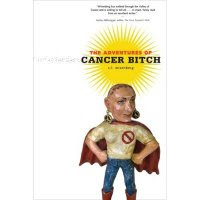I've been wandering around the neighborhood, scouting out stores that look like they might sell hats or wigs. Last night I went to punk store that had mannikins in the display window wearing red, black and white scarves. Like they were just waiting for Cancer Bitch, ready to tell her that scarf-wearing was fashionable. Inside the music was blaring. There were little displays of hats, mostly berets. I don't need scarves. I don't like them. There were a few punk wigs that looked promising, for later. I went to another store that specialized in accessories for bachelorette parties. The closest useful thing I found was a plastic halter that had three breasts on it. I thought I could wear it for my follow-up exam with the surgeon. I would put it on under the gown and say, Doctor, I've been feeling funny... Or better yet, try it on the Fellow first.
It took a while to figure out what I'm looking for are "fun wigs"--colored, unrealistic, maybe $10. Not hairpieces I would waste my "cranial prosthesis" prescription on. I don't want a realistic wig. A couple of places referred me to a nearby store that was closed right then. I've been in the neighborhood long enought to remember it as the place where the Bread Shop used to be. It was an independent bakery and health food store. Then it was a candy store. Now it's a retro-fun-dress-up kind of place. There are a number of those in the area. Vintage. Costume. With loud music and bored-looking hipsters at the cash register.
Today I was walking from the post office and stopped in a store that I'd never seen open before. It was one of those storefronts that's so messy that it seems between rents. But the door had an Open sign on it. When I went in, a bell rang. I could hear someone coming up basement stairs. The place was narrow, with red walls. Painted on them for no obvious reason were: Theatre, Laundry, Kitchen. The space was filled with racks and racks of costumes. Black and gold corsets. Blue net. So much of muchness you couldn't say what was what. The woman came up. She had slightly buck teeth and wore a faded denim skirt. I asked if she had wigs. She pointed to some. I have wigs here, and here, she said. They were hanging on a wall, and seemed worn. They were across the room, too. A red yarn one, as from a Raggedy Ann. Long dark wigs. Blue. I felt persnickety, but I didn't want a wig that wasn't sealed up in a bag. I didn't want one that had been hanging on a hook for decades. She said she had blond ones. Do you have purple? I asked. I don't have purple wigs, she said. I'm not a wig store, darling, she said. It was like being backstage of a huge theater. In the back room were shiny Mardis-Gras bead necklaces. Everything was old and used-looking and historic. The place was dense with fabric. I'm reorganizing today, she said, to get ready for the Cubs. I'm not a wig store, darling, she kept saying. Apparently she was going to have Cubs-related clothing ready for the start of the season next week. She said to come back later. She gave me her card. It was a photocopied square of paper with the name of the store, a drawing of a dominatrix with whip and "Collectibles, Bath products, Make-up and Seasonal gifts." As I left I saw jars of bath salts, with hand-written labels.
I felt like I had just been in a Mary Poppins story, and that the store and its proprietor might vanish overnight. This is the sort of place that doesn't spring up in my neighborhood, where the hair salons can be as airy and spare as the sushi bars, with Product displayed in diagonal rows, and the restaurants have all their reviews color-photocopied and taped up outside. Oh, not everything's self-conscious and interior-decorated, but that's the trend. What is authentic? Around the corner from that store is a historic block of townhomes that's on the National Register. They're patterned after rowhouses in London. The street reminds me of frozen-in-time street in East Berlin. My friend R, who lives there, hated it, for being so fake and perfect.
This is the home of the concept restaurant. I remember going to a restaurant that was supposed to be set in a border town between Spain and France. You were supposed to feel that you were in both countries, and none. The walls were fakely aged and the food was more or less Italian. Much of the food here is more or less Italian.
We went to New York between Christmas and New Year's and I brought a guide to historic restaurants and stores. They all sounded wonderful, but a number were so touristed-out that their souls had been wiped away. I'm looking through the book now to figure out which Italian bakery it was that sounded so promising and pleasing, with green-patterned tile floor and great-grandchildren lovingly creating the family recipes. Can't find it. But I remember going to a crowded place where the pastry didn't look so great and squeezing into a table, surrounded by tourists (as if we weren't), and feeling that nothing was left. We saw a man come out from an office door and sit down with another man and do some sort of business with papers, and that seemed real. Maybe real has to do with the day to day. With duty. Can nothing a tourist "discovers" be real, then? In Barcelona several years ago we went to a store that sold fans. The whole place was paneled in wood and behind the counter there was more wood. Drawer after drawer, I think. I asked L tonight if he remembered it. He did. Did they sell just fans? I asked. Or fabric? Just fans, he said. There was something solid and beautiful about the store. For one, the way it looked. There may even have been a sign somewhere attesting to how long it had been in business. I've always felt comforted by old wood, especially if it's carved. I don't like modern much. I love Italianate buildings. The streets in my neighborhood are filling up with dense ugly brick condos. I wonder if, decades from now, they'll ever be seen as having "character." That's hard to imagine.
In New York we walked around the Upper West Side around Columbia, where Broadway gives way to one franchise after the other. Starbucks was everywhere. I wanted to go to the Hungarian Pastry Shop and we found it by calling Information. It was on Amsterdam Avenue, which isn't as ruined as Broadway. I'd been to the Hungarian a couple of times before. We stood at the counter. An elderly woman accused us of elbowing our way in front of her, and we let her pass. We sat down. I wrote and L read. About 45 minutes passed. We suspected, then confirmed, that there was no table service. We went up the counter and ordered apple streudel. I probably had cappuccino. Two girls behind the counter spoke Amharic to one another. (I asked.) I copied down some of the kinds of coffee drinks--Hungarian coffee: American coffee, almond extract, whipped cream and cinnamon. Viennese: espresso, steamed milk, whipped cream. Russian: espresso, hot chocolate, whipped cream. You could help yourself to refills of regular coffee. All day. I could imagine spending the summer in New York and writing at the Hungarian. The bathroom was very literate--quotes from Larkin, Eliot, Stevens, Dylan Thomas. On the wall toward the front of the cafe were framed covers of books that had been written in the cafe. So it wasn't a place entirely unconscious of itself. You could also buy post cards. Which I did.
***
(The thing is we each want to be irreplaceable, and if we can't have that, then we want to know that there's a building or a concept or a history that's irreplaceable. Immutable. Immortal. That's why people will martyr themselves to a religion or idea, like Patria. It's comforting that X will stand forever: I built the Pyramids/the Eiffel Tower/ the Empire State Building/ the World Trade Center...
Jerome Groopman dedicates his book on hope to his children, asking, what greater hope is there? Where does it leave those of us without children? We just have our words, spun out in the universe...)
skip to main |
skip to sidebar

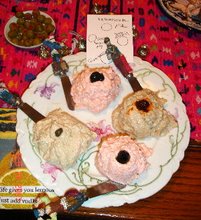
taramosalata & other dips; photo by Vera Szabó
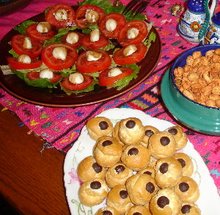
cream puffs, caprese; photo by Vera Szabó

Don't try this at home. Uh, oh, we did.

L the Haircutter in Background
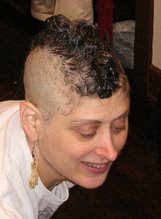
Finished.
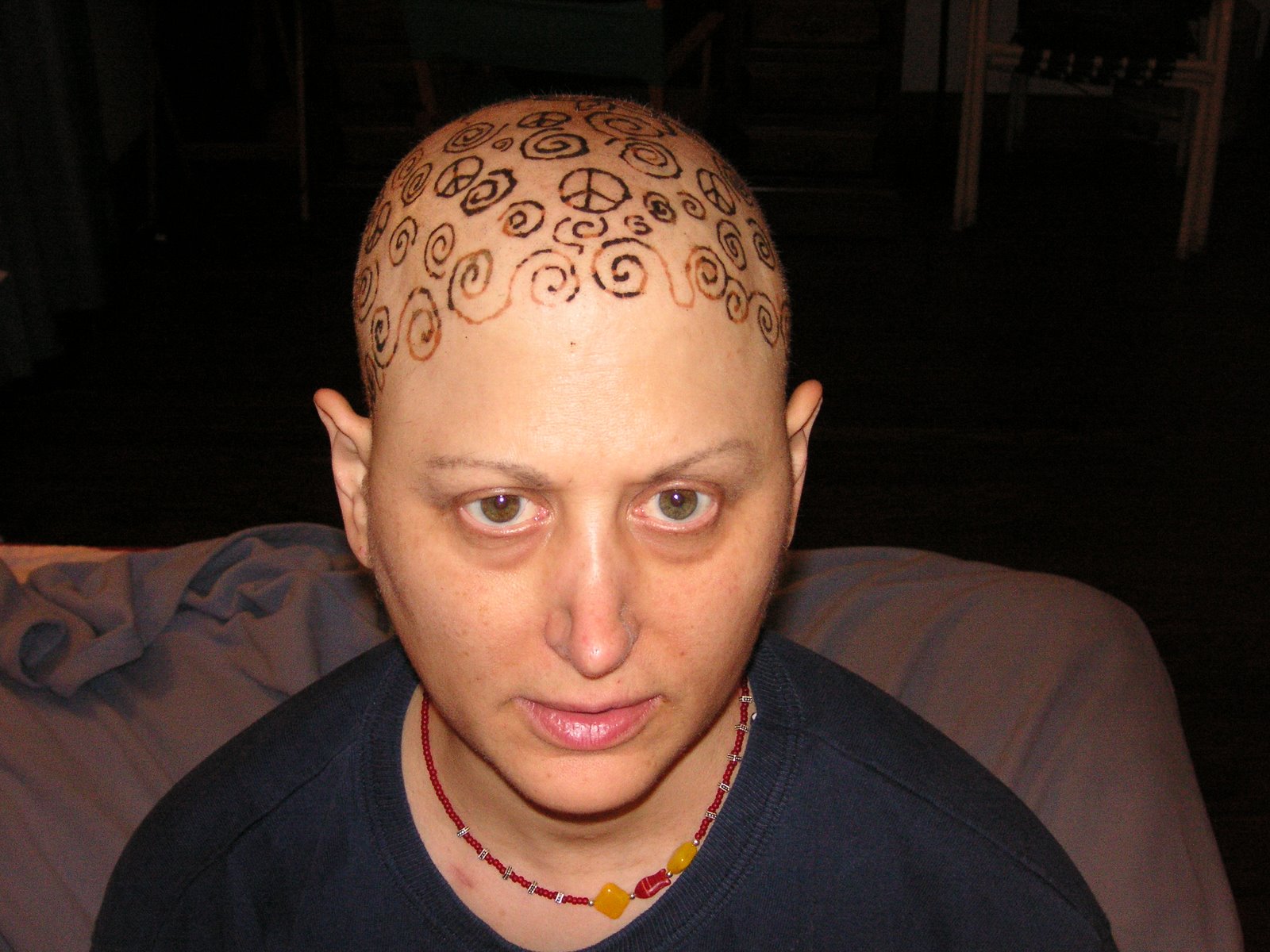
design by Jennifer Berman

At medicinal baths, with testimonials from patients
One Feminist's Report on Her Breast Cancer, Beginning with Semi-diagnosis and Continuing Beyond Chemo, w/ a side of polycythemia thrown in **You don't have to be Jewish to love Levy's rye bread, and you don't have to have cancer to read Cancer Bitch *** Cancer Bitch comes to you from S.L. (Sandi) Wisenberg in Chicago
Click on photo for Cancer Bitch reading/lecture schedule
Blog Archive
-
▼
2007
(192)
-
▼
March
(34)
- Hamlet & Fools
- The Circle
- The Stores
- The Peace Flag
- Shopping/Water
- Acupuncture Folo-folo
- Chemo..
- Why I Hate Elizabeth Edwards
- Acupuncture Follow-Up
- I Get Acupuncture
- A Brighter Shade of Pink
- Mr Toad
- Gender: Hiding the Evidence
- War
- My First Hair Cut of 2007
- The Neighbor Boy
- News/Heart
- Happy
- Hair
- Contest Winner!
- The Cancer Card
- The Prestidigitator
- Bad News, East & West
- A Contest!
- What is a Meltdown?
- The Mysteries
- When a Double Negative is a Positive
- Telling--Part 2
- Pictures of torture victims?
- The Angel
- Wet Spot
- Looking At It
- Drain Bulbs
- I Have Returned
-
▼
March
(34)
Cancer Bitch recommends these links:
- Alternet.org
- As the Tumor Turns
- Being Cancer--its on-line book club discusssed my book.
- Big Grrls DO Cry: queer life meets precarious life
- Black Gyrl Cancer Slayer
- Breast Cancer Action
- breastcancer.org
- Chemo Chicks
- Chronic (Illness) Babe
- Code Pink women's peace group
- Collaborative on Health and the Environment
- Colon cancer cowgirl
- Earth Henna
- Friends of Cancer Bitch on Facebook
- Funny Cancer shirts and mugs
- Gayle Sulik, Pink Ribbon Blues
- Geezer Sisters (tho' only written by one of them)
- Get Real About Breast Cancer (w/ pic of Breast Cancer Barbie)
- Gilda's Club
- Goodbye to Boobs (by a pre-vivor)
- Humerus Cartoons
- I got the cancer (lymphoma)
- Mamawhelming
- Organic Consumers Assn.
- Our Bodies, Our Blog
- Paula Kamen
- Planet Cancer
- Recovery on Water
- S.L. Wisenberg/Red Fish Studio
- Skin Deep: un/safe cosmetic list
- Stacey Richter's Land of Pain
- Swimming in the Trees: author Jessica Handler of Atlanta
- Tara Ison
- Terry Tempest Williams
- The Assertive Cancer Patient
- The Cancer Culture Chronicles
- The Fifty-Foot Blogger, another denizen of Fancy Hospital
- Whirled News--better than the Onion
- Women & Children First bookstore
NOTATE BENE
Everything here is as accurate as I could make it. Occasionally I've changed identifying details when writing about others.
Links to audio and video

from my Farewell to My Left Breast party

taramosalata & other dips; photo by Vera Szabó
Farewell to My Left Breast Party

cream puffs, caprese; photo by Vera Szabó
April 12, 2007--The Making of the Mohawk

Don't try this at home. Uh, oh, we did.
The Mohawk Profile

L the Haircutter in Background
The Mohawk Demure

Finished.
Summer henna-wear
design by Jennifer Berman
Life after cancer, Budapest, July 2009
At medicinal baths, with testimonials from patients
